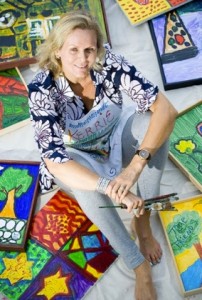“Through positive self-expression the doors of opportunity will open,” is the mission statement for the nonprofit Art Walk for Kids/Adults. It could also be the motto for the life of Art Walk’s founder, Kerrie Kilpatrick-Weinberg.
“Art Walk has opened so many doors for me in Santa Barbara, friendships, the areas I work. It’s amazing how things flow into one another when you’re on that right path,” says Kilpatrick-Weinberg, who trained as a set designer in England before developing Art Walk in Santa Barbara in 2000. The program–which is suitable for all but designed for at risk and special needs students–uses the creation of art projects to teach students other academic skills like math, problem solving, reading and understanding directions.
Working around the schedules of her two sons, Ben (now 15) and Sam (now 10), Kilpatrick-Weinberg–who was then a single mother and met her husband Henry Weinberg through Art Walk–began the program as an informal art camp in her backyard. From there she segued into working with the home schooling community, then Devereux’s developmentally disabled students.
She credits her brother Nigel, who was autistic, for inspiring her work. “The hyperactive, the kids with ADHD, the kids who some people call special needs, I just call creative,” she says. “I’ve always done art with any kid that has a learning difference. That seems to be my area, my gift. I don’t find it challenging, I find it really my normal comfort zone because of Nigel.”
With a full art program soon in place at Devereux, Kilpatrick-Weinberg set her sights on expanding to the Los Prietos Boys Camp, a residential correctional/treatment facility for teens.
With the support of the County Arts Commission and the County Education Office, and some funding from the Fund for Santa Barbara, Kilpatrick-Weinberg began her journey into what she calls “the golden triangle,” of Los Prietos Boys Camp, Juvenile Hall and El Puente School, which serves students who have been expelled or imprisoned and are transitioning back to school.
“I would develop this relationship with a kid in Juvenile Hall, then I would see them at Los Prietos for six months, then if things went well they went back to school and they went back to El Puente, so I would have another relationship with them,” says Kilpatrick-Weinberg.
“Some of those kids I knew two years, from beginning to end. It was great to see how well they were doing because a lot of them had given up on themselves, and I’m not saying it was just Art Walk, but the whole process … was immensely life changing for them.”
That continuity of relationships is important. “A lot of the people we work with don’t like too much change,” she says. When Devereux announced closure of its residential program, Kilpatrick-Weinberg began Chagall House so that her autistic adult students could continue to create art. They meet every Wednesday night, have showings of their work around town, and get together for dinner regularly at the Weinberg house, where they catch up socially and discuss and critique their art. Henry, Ben and Sam all take part.
“These are my friends, they’re not just people I create with. They’ve become part of our family,” says Kilpatrick-Weinberg.
Another important part of the Art Walk family is Brandon Sonntag, an artist and teacher who has been collaborating with Kilpatrick-Weinberg since 2001. “It’s just the two of us. There’s something very nice about having two people who get along, who know how to bring out the best in our clients,” she says.
In addition groups already mentioned Art Walk collaborates with a host of other organizations, including local elementary schools, Hillside House, Patricia Henley Foundation, United Nations, Summit for Danny, United Way, Red Cross, Cancer Hope Foundation, Camp Reach for the Stars, Sarah House, Santa Barbara Symphony, Lobero Theatre, and I Madonnari, among others.
One would think her volunteer plate was overflowing from Art Walk, but Kilpatrick-Weinberg still finds time to help at her sons’ schools, and serve on the board of Sarah House, where she and Henry have hosted an annual Oscar Party benefit for the past three years. For the second year, she is also chairing Sarah House’s annual holiday fundraiser–“Light Up the Night: The Artizan’s Ball”–on December 8 at the Santa Barbara Women’s Club.
But Art Walk has opened the door to so many other things for Kilpatrick-Weinberg–including Sarah House, where she first became involved by creating an Art Walk art tree that was auctioned for “Light Up the Night”– that it’s Art Walk that’s closest to her heart.
“Art Walk is a healing program in many ways, it isn’t just about at risk or special needs; it’s about anybody who wants to create. It’s art walk for kids and adults. What it probably should be is art walk for everyone because that’s what it is,” she says.
==
For more information about Art Walk for Kids/Adults visit http://www.artwalkforkids.org.


